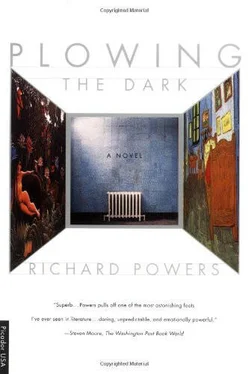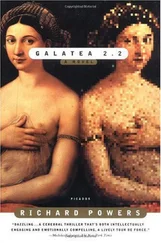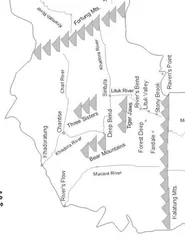The hive hummed, like so many scraps of animated paper. Lim and company quadrupled the pipelines and octupled the graphics-processing arrays that ran each wall. Da Vinci, Claude, Hsieh Ho, Rembrandt, and Picasso wordlessly endured their brain surgeries, returning from their trips to digital Italy with more painting ability in their spinal cords than they previously enjoyed in their entire cerebella. And so the project moved forward, recapitulating the quattrocento assault on plastic realism.
Kaladjian screwed down the calculation of Euler angles so tightly they began to scream. Loque tuned the hidden-line removal, speeding up the z-buffer algorithm. Da Vinci and friends, now faster in discarding all the points invisible to the eye, had that much more processing power to spare for the visible planes.
Rajan Rajasundaran worked on foveal concentration. Only the smallest fraction of the eye actually saw with any degree of resolution— say 5 percent of the full field of vision, with the rest shading off into soft focus. If the human eye could get away with that massive shortcut, why should the Cavern have to work any harder? Like everything else at the RL, head tracking doubled its performance every other month. Pupil tracking followed in its wake, suffering only from occasional bouts of the Midas touch, where everything that the user looked at triggered an unwanted mouse click. Minor kinks aside, the Cavern knew, at any instant, just what the user looked at. It even opened a comprehensive log file of the retina's itinerary. Monitoring the glance, the Cavern could concentrate its growing rendering power on the center of that slice, sliding around a high-resolution insert in front of the moving gaze. The trick grew impossible for multiuser expeditions. But Rajan felt alive only when pitting himself against what others discarded as impossible.
For a few weeks, the Cavern's capabilities outpaced the demands of its suite of chameleon rooms. Software struggled to keep pace. Reserving time in the grotto to prototype a new environment became tougher. Slots filled up weeks in advance, all hours spoken for by a queue of researcher squatters, giddy with the pace of forward motion.
The drabbest of new rooms hid the most awesome software drivers. Stance's and Kaladjian's microclimate test bed looked like a passel of stained Popsicle sticks poorly glued together. The user floated omni-sciently above a stylized eastern Washington, zoomable from a hundred miles per yard down to about ten. The view could pitch and roll and yaw, peering straight down on the map or swooping tangent to the surface to expose a crude topographical relief that resembled piled-up
pillbox hats.
But the map was just the placeholder for the real pizzazz. Under the hood lay all the region's nooks and crannies, the details of local soil albedo and solar radiation, air pressure and water current domesticated into mathematics. Alongside these, compacted into the same code, lay the full scope of physical law — thermal convection and conduction, hydrologic processes, turbulence. The simulation played on the chief insight of the Information Age: the interchangeability of data and command. The Cascades were a set of data points, elemental elevations, rules in their own right, programming the air where to split and rise. By the same token, the laws of adiabatic cooling produced their own data set in the shape of the Cascade Glacier.
A click of the left wand button colored the air in a temperature gradient from rose to cobalt. Each shaded band stood for an isobar. A click of the middle button toggled a hailstorm of vectors — pulsating Aeolian arrows whose curl and thickness, like so many coasting petrels, revealed the caprice of wind. The right button placed and removed centers of pressure, adjusted the sawtooth fronts, painted in cloud banks, and otherwise granted control over the palette of meteorological events. With time, patience, and a satellite weather map, Kaladjian and Stance could reproduce the prevailing conditions of the previous day. Then, like the best of Deist deities, they stood back and let their clockwork turn.
The whole round of the bruised horizon then went grandly processional. Over grim Olympus, across the straits of Juan de Fuca, the lanes of atmosphere released their own vital throes. Points of storm and sunburst smeared outward, spreading like time-lapse microbes. Local conditions reciprocally persuaded their neighbors, rippling outward along a weighted average. Temperatures flumed. Rains fell and rose again to fall. The weather map became the weather. From east to west, projectors spread a panorama wider than any glance could consume. The wand's thumbwheel fast-forwarded the live-in movie or slowed it to a frozen frame. Spun past zero, the film ran in reverse. Floods got sucked back up into whitening cumulus. Winds unsplit, reconstituted themselves, backing off the mountain's wedge.
As a predictor, the Weather Room was worthless. Noise crept in at the edges, for the simple reason that the would-be world had edges. They dropped off like the incognitas of old cartography, the blank spaces filled in with the guesswork variable: Past this point, monsters. Across the map's center, fronts spread well, feeding off the turbulence around them. But at the extremes of the compass, data ran out. Storms on the simulation's boundaries ran aground on the nothingness adjacent to them. Weather grew contaminated by its opposite, and flaws spread through the dataset until clouds and rains and winds and temperatures lapsed into pure fiction.
But as a test, the Weather Room passed with flying colors. Oceans of air could be mounted and hung, made to behave credibly in a display that beat any other attempt to visualize them. The maps would grow, expanding the length of time that these weather pockets preserved their real-world referent. The day would come when a Cavern navigator might reach the east by wanding off at a healthy clip to the west. Then this room, like the one it stood for, would wrap back onto itself and lose its contaminating boundaries.
Until then, the Weather Room remained a triumphant tease. Its sea breezes blew in, reeking of strong mathematics. Red skies at night: analytic geometer's delight. Despite the primitive block graphics, the panorama of heat and cold showed off the hardware to maximum advantage. And in its spiderweb algorithm — each point on the map calculating all the others — the Weather Room became a microcosm of the world machine at large.
Only O'Reilly's Economics Room rivaled it. But Ronan worked by himself, as yet unwilling to trot out his rough drafts in front of the critical public. His displays remained abstract shows of hue and contour, smashing as theater, but as thesis, illegible — a Labanotation readable only by the enlightened novitiate. His multiagent economies were like brilliant autistic children. They had answers, but could not speak them. It took some months for him to admit it, but for any coherent macroeconomic display, O'Reilly needed a simplified interface.
A guided tour of the Weather Room, from which he emerged shaken, inspired Ronan to write one. The choice all but made itself: a world globe, the whole geopolitical pizza pie, sliced down to subna-tional regions, the slightly pear-shaped sphere spinning on its canted axis, with its chance tilt of 23.5 degrees off the ecliptic sufficing to decide the entire human cycle of decline and renewal, the variations in latitudinal destiny that rendered one soul implacably Hindu and another an evangelical Protestant. But even a globe, projected by the Cavern, was no mere globe. Focused in space by five convergent projectors, this one came down off the front wall to float freely in space, in the volume of vacant air.
The first time he coaxed the spinning marble down into the room, even O'Reilly, its nominal author, could not keep from swiping at it. A little wrist action on the wand — something that those from less charged regions of said globe insisted on calling body English — and he learned how to bat the thing around the room like a glorified beach ball. While engaged in a private match of planetary jai alai, he failed to notice Adie Klarpol's Labrador nosing its way in through the Cavern door. Mistaking the ghostly orb for a moon gone violently wrong, Pinkham went off the doggy deep end, baying uncontrollably, until Adie dragged him away and chained him up.
Читать дальше












